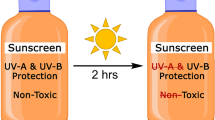Summary
The spectral absorption by single granules, clusters and masses of granules of the screening pigment in the compound eye of the butterfly genusHeliconius was studied by microspectrophotometry. Most of the pigment granules were found to have an almost constant absorption in the wavelength region 300 to 700 nm. Other granules showed a maximal absorption either at about 450 or 560 nm. The maximum at 450 nm is suggested to be caused by xanthommatin and that at 560 nm by ommines. The pigment screen inHeliconius is concluded to be a neutral grey filter.
Similar content being viewed by others
References
Autrum, H.: Die spektrale Empfindlichkeit der Augenmutationwhite-apricot vonCalliphora erythrocephala. Biol. Zbl.74, 515–524 (1955).
Bernhard, C. G., Boethius, J., Gemne, G., Struwe, G.: Bye ultrastructure, colour reception and behaviour. Nature (Lond.)226, 865–866 (1970).
Burkhardt, D.: Spectral sensitivity and other response characteristics of single visual cells in the arthropod eye. Symp. Soc. exp. Biol.16, 86–109 (1962).
Butenandt, A., Neubert, G.: Über Ommochrome, V. Xanthommatin, ein Augenfarbstoff der SchmeißfliegeCalliphora erythrocephala. Hoppe-Seylers Z. physiol. Chem.301, 109–117 (1955).
Chance, B., Perry, R., Åkerman, L., Thorell, B.: Highly sensitive recording micro-spectrophotometer. Rev. Sci. Instr.30, 735–741 (1959).
Crane, J.: Imaginai behaviour of a Trinidad butterfly,Heliconius erato hydara Hewitson, with special reference to the social use of colour. Zoologica40, 167–196 (1955).
Ephrussi, B., Beadle, G. W.: A technique of transplantation forDrosophila. Amer. Nat.70, 218–225 (1936).
Goldsmith, T. H.: Do flies have a red receptor ? J. gen. Physiol.49, 265–287 (1965).
Höglund, G., Langer, H., Struwe, G., Thorell, B.: Spectral absorption by screening pigment granules in the compound eyes of a moth and a wasp. Z. vergl. Physiol.67, 238–242 (1970).
Langer, H.: Über die Pigmentgranula im Facettenauge vonCalliphora erythrocephala. Z. vergl. Physiol.55, 354–377 (1967).
Langer, H., Hoffmann, Ch.: Elektro- und stoffwechselphysiologische Untersuchungen über den Einfluß von Ommochromen und Pteridinen auf die Funktion des Facettenauges vonCalliphora erythrocephala. J. Insect Physiol.12, 357–387 (1966).
Langer, H., Schneider, L.: Lichtsinneszellen. In: Lehrbuch der Cytologie, ed.: H. Ruska. Jena: VEB Fischer 1972 (in press).
Strother, G. K.: Absorption ofMusca domestica screening pigment. J. gen. Physiol.49, 1087–1088 (1966).
Struwe, G.: Spectral sensitivity of the compound eye in butterflies (Heliconius). J. comp. Physiol.79, 191–196 (1972).
Swihart, C. A.: Colour discrimination by the butterfly,Heliconius charitonius LINN. Anim. Behav.19, 156–164 (1971).
Swihart, S. L.: The electroretinogram ofHeliconius erato (Lepidoptera) and its possible relation to established behaviour patterns. Zoologica48, 155–156 (1963).
Swihart, S. L.: Maturation of the visual mechanisms in the neotropical butterfly,Heliconius sara. J. Insect Physiol.13, 1679–1688 (1967).
Swihart, S. L.: Single unit activity in the visual pathway of the butterflyHeliconius erato. J. Insect Physiol.14, 1589–1601 (1968).
Author information
Authors and Affiliations
Additional information
This work was supported by the Swedish Medical Research Council, grant No. B71-14X-104 06B and 070, Sällskapet för Medicinsk Porskning and Reservationsanslaget, and the Deutsche Forschungsgemeinschaft.
Rights and permissions
About this article
Cite this article
Langer, H., Struwe, G. Spectral absorption by screening pigment granules in the compound eye of butterflies (Heliconius). J. Comp. Physiol. 79, 203–212 (1972). https://doi.org/10.1007/BF00697773
Received:
Issue Date:
DOI: https://doi.org/10.1007/BF00697773




